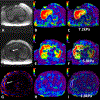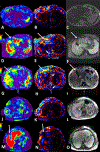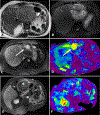Magnetic resonance elastography: beyond liver fibrosis-a case-based pictorial review
- PMID: 29143076
- PMCID: PMC6731769
- DOI: 10.1007/s00261-017-1383-1
Magnetic resonance elastography: beyond liver fibrosis-a case-based pictorial review
Abstract
Magnetic resonance elastography (MRE) has been introduced for clinical evaluation of liver fibrosis for nearly a decade. MRE has proven to be a robust and accurate technique for diagnosis and staging of liver fibrosis. As clinical experience with MRE grows, the possible role in evaluation of other diffuse and focal disorders of liver is emerging. Stiffness maps provide an opportunity to evaluate mechanical properties within a large volume of liver tissue. This enables appreciation of spatial heterogeneity of stiffness. Stiffness maps may reveal characteristic and differentiating features of chronic liver diseases and focal liver lesions and therefore provide useful information for clinical management. The objective of this pictorial review is to recapture the essentials of MRE technique and illustrate with examples, the utility of stiffness maps in other chronic liver disorders and focal liver lesions.
Keywords: Acute hepatitis; Amyloidosis; Congestive hepatopathy; Diffuse liver diseases; Elastograms; Focal liver lesions; Infiltrative diseases; Primary sclerosing cholangitis; Sarcoidosis.
Conflict of interest statement
Figures



























Similar articles
-
Magnetic resonance elastography: basic principles, technique, and clinical applications in the liver.Diagn Interv Radiol. 2018 Nov;24(6):328-335. doi: 10.5152/dir.2018.18186. Diagn Interv Radiol. 2018. PMID: 30272563 Free PMC article. Review.
-
Prospective comparison of transient, point shear wave, and magnetic resonance elastography for staging liver fibrosis.Eur Radiol. 2019 Dec;29(12):6477-6488. doi: 10.1007/s00330-019-06331-4. Epub 2019 Jul 5. Eur Radiol. 2019. PMID: 31278577
-
Magnetic Resonance Elastography of Liver: Current Update.Top Magn Reson Imaging. 2018 Oct;27(5):319-333. doi: 10.1097/RMR.0000000000000177. Top Magn Reson Imaging. 2018. PMID: 30289828 Free PMC article. Review.
-
Magnetic resonance elastography of liver.Magn Reson Imaging Clin N Am. 2014 Aug;22(3):433-46. doi: 10.1016/j.mric.2014.05.001. Magn Reson Imaging Clin N Am. 2014. PMID: 25086938 Free PMC article. Review.
-
MR elastography in primary sclerosing cholangitis: a pictorial review.Abdom Radiol (NY). 2023 Jan;48(1):63-78. doi: 10.1007/s00261-022-03529-x. Epub 2022 May 14. Abdom Radiol (NY). 2023. PMID: 35567617 Free PMC article. Review.
Cited by
-
Added value of multifrequency magnetic resonance elastography in predicting pathological grading of pancreatic neuroendocrine neoplasms.Insights Imaging. 2025 Jun 12;16(1):119. doi: 10.1186/s13244-025-02008-3. Insights Imaging. 2025. PMID: 40506609 Free PMC article.
-
Normative Pancreatic Stiffness Levels and Related Influences Established by Magnetic Resonance Elastography in Volunteers.J Magn Reson Imaging. 2020 Aug;52(2):448-458. doi: 10.1002/jmri.27052. Epub 2020 Jan 14. J Magn Reson Imaging. 2020. PMID: 31943515 Free PMC article.
-
Skeletal muscle stiffness as measured by magnetic resonance elastography after chronic spinal cord injury: a cross-sectional pilot study.Neural Regen Res. 2021 Dec;16(12):2486-2493. doi: 10.4103/1673-5374.313060. Neural Regen Res. 2021. PMID: 33907038 Free PMC article.
-
Magnetic resonance elastography: basic principles, technique, and clinical applications in the liver.Diagn Interv Radiol. 2018 Nov;24(6):328-335. doi: 10.5152/dir.2018.18186. Diagn Interv Radiol. 2018. PMID: 30272563 Free PMC article. Review.
-
Elastography Techniques for the Assessment of Liver Fibrosis in Non-Alcoholic Fatty Liver Disease.Int J Mol Sci. 2020 Jun 5;21(11):4039. doi: 10.3390/ijms21114039. Int J Mol Sci. 2020. PMID: 32516937 Free PMC article. Review.
References
Publication types
MeSH terms
Grants and funding
LinkOut - more resources
Full Text Sources
Other Literature Sources
Medical
Research Materials

